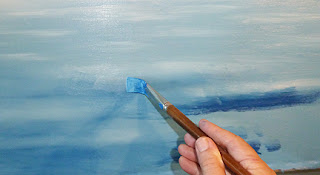This is my last post on this painting. Okay, stop applauding...
I have now completed all the detail work on the boats and background and ready to complete the reflections on the water just under the boats.
Again, I worked from left to right in putting in and correcting the reflections in the water. I have to stand back and look at the objects and then look down at the reflections to make sure they look right. I am not afraid to make changes at this point.
The reflections are more distinct the closer to the object, and then lose some of their color and start breaking apart as they come to the viewer. The photo for this painting was taken from across the harbor, so the perspective on the reflections become very horizontal.
As a rule, reflections that come from an object that is actually touching the water will be the exact same distance from top to bottom as the object. I use my brush to do a quick check on this by placing the brush in front of the object and put my finger on the distance. Then, I move the brush down and see if the reflection is ending at the right distance. The more the water is breaking the reflection the more this distance can change slightly as a little wave or two is catching the reflection of the object beyond the correct distance. If the water is perfectly still, the distance would be exactly the same.
Here is a detail of a boat reflection that I stopped to tackle. Again, I knew I was going to do this when I got to it.
See the bluish strip along the bow of this red boat? The red is reflected, but that strip is not. Actually, the boat didn't actually have the strip on it, but I liked how it gave it definition and a more crisp detail.
So, here is the reflection of the strip painted in.
There is a lot of glare on the canvas surface from my flash, but you get the idea.
Again, my palette working at this stage.
I just kept going touching up, cleaning up shapes, altering colors, looking up at the objects and down at their reflections until I reached the other side. Many of these reflections are quick brush strokes using a twisting action with the brush, trying not to be too perfect.
Now that I was satisfied with the reflections (you have to make yourself stop), I was ready to move on with the touchup on the sky. I knew when I painted the lighter area of sky that this point would come where I had to match the color and value of the sky next to all the stuff in front of it. So, I made sure up front that I was only using Cobalt Blue and White. That makes this part so easy!
I placed a chunk of white and small squeeze of Cobalt Blue on my palette. I grabbed another palette than the one I had been using because I knew it was perfectly clean/dry and would not discolor the paint I needed.
Just a small dab of blue makes a big difference to the white. The light sky stays consistent from left to right and top to bottom because I had mixed a large batch of it before I started painting it. The only change it makes is when it reaches the darker blue above it. There is a soft transition at that point, which makes it more difficult, but not impossible.
So there I went, from left to right, touching up, defining, etc. One problem I have in Costa Rica, which I also had some of on the Texas Coast, is bugs! Those little suckers love to fly right into my wet paint. Throughout the painting process I am picking them off and making small touchups.
Where I am now, not only do I have bugs, but this darn studio ceiling is made from cane with a tin roof covering. No AC means leaving the door open for air and a fan constantly blows on me. There is all this tiny little stuff that falls from the ceiling, plus the dogs, who love to lay under my tables while I am in here, shed little hairs which the fan promptly blows all around.
Thus, this is the stage where I carefully go over the whole painting and look for anything foreign in the paint. It took a couple of hours to go across the painting touching up the sky and getting rid of trash.
It is such a good feeling to stand back and say, " It's now ready for my signature!"
I always use the same signature. The larger the painting, the larger the signature. I have developed a series of brush strokes that create this particular one. You can see that I stayed far away from the edges of the canvas. That is because about two inches of canvas will go around the final stretcher bars that my son, Robby, will use when he receives this piece for display at the Felder Gallery.
I'm a big believer in having your signature show. Maybe its my marketing background, but when someone walks into a room and sees one of my paintings I don't want there to be any question about who the artist is. That type of "branding" is important to an artist, and should be important to the collector as well. A buyer who doesn't like the artist's signature to show should buy a photograph.
So, here's the final painting completed and drying in my studio. The photo isn't that good, but it does show the whole thing at one time. I hope you have enjoyed reading about this process and seeing the results. I'll be coming back soon with another one.
Meanwhile, "Pura Vida!" as they say in Costa Rica.






















































